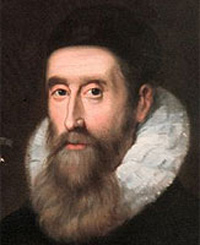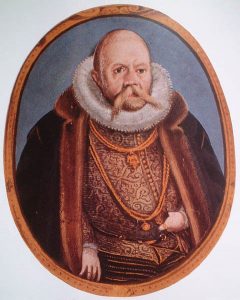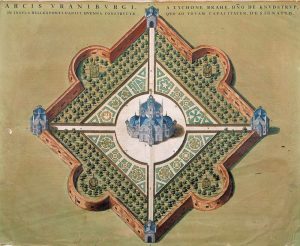
4 April 2017 marks the 400th anniversary of the death of John Napier, one of the inventors of logarithms, the other being the Swiss Joost Bürgi. The invention of logarithms has a lot to do with their main property: that of converting products into sums: \(\log (xy)=\log(x)+\log(y)\).
This property is very useful when you want to multiply numbers with many digits and you don’t have calculators or computers at hand. Since ancient Greece, multiplying numbers with many digits was a common task in astronomical observatories, and any idea that would simplify these tedious calculations was considered welcome. Until the invention of logarithms, the reduction of products to sums was done using the trigonometric formula
$${\rm sen}(x){ \rm sen}(y)=\frac{\cos (x+y)-\cos (x-y)}{2};$$
Indeed, suppose we want to multiply two numbers \(a, b\) with many digits; using a trigonometric table we look for two numbers \(x, y\) so that \({\rm sen}(x)=a\) and \({\rm sen}(y)=b\). If we now use the above formula
$$a b=\frac{\cos (x+y)-\cos (x-y)}{2},$$
and using the table again we calculate the cosines that appear in the second member of the equality, with which the product has been reduced, by means of the trigonometric tables, to three sums and a very simple division by two. This method was called prosthaphairesis.

There is, in fact, a connection between prosthaphairesis and Napier; a connection that could almost serve as a script for a Hollywood adventure blockbuster. At the end of the 16th century, James VI reigned in Scotland; he was the son of Mary Stuart and also succeeded to the throne of England in 1603. In 1589 it was decided that the king should marry Anne of Denmark. The marriage was first arranged by proxy, until an expedition went to Denmark to find the queen. John Craig, the king’s physician and a friend of John Napier – who was a Scottish nobleman – took part in the expedition. Due to storms, the ship was forced to seek refuge on the island of Hven, located between the coasts of Denmark and Sweden. This was the site of Tycho Brahe’s astronomical observatory, probably the best of its time. Brahe was the greatest observational astronomer – before the invention of the telescope; legend has it that he lost part of his nose in a duel over the existence of imaginary numbers; he replaced it with a prosthesis made of silver… or gold… But perhaps it was copper, or at least that was the conclusion reached in 1901 when, on the occasion of the 300th anniversary of Brahe’s death, they decided to open his grave to check whether or not there was a nasal prosthesis among the astronomer’s bones. Whatever material Brahe’s prosthesis was made of, it must have given him a most disturbing appearance.
Brahe called his observatory Uraniborg, “Castle of Heaven”; it had been built to the plans of the Freemason architect Hans van Steenwinkel, full of symmetries and dimensions of symbolic and esoteric intent.

It featured comforts and luxuries that were unusual in the 16th century: the rooms were said to have running water, and to be inhabited by clairvoyant dwarves and giant moose who quenched their thirst with beer rather than water – Brahe’s favourite animal is said to have been broke his neck one night after rolling down a flight of stairs in a drunken stupor. Outside there were aviaries, gazebos, belvederes and a medicinal herb garden that supplied the apothecary built in the castle’s cellars; Brahe and, above all, his sister Sophia – who was one of his main assistants – were very fond of botany and alchemy. Brahe even went so far as to build a system of dams on the island to power a paper mill that supplied his private printing press.
From the paradise Brahe built for himself on Hven he was eventually driven out by his excesses and the young King Christian IV. Brahe left his island in 1597 for Germany. The wrath of the peasants of Hven, whom Brahe had squeezed by means of taxes and levies which he collected with enormous voracity and inhuman cruelty, led to the partial destruction of their castles shortly after Brahe left them; the passage of time completed the task. Even so, a visit to the island of Hven is still worthwhile today: an hour and a half ferry ride from Copenhagen, you can hire a bicycle and cycle around the island in six or seven hours. Although only a few ruins remain of Brahe’s observatory, they are so evocative that when the wind blows through them it seems to emulate Brahe’s cries to his assistants for more careful observations.
During his brief stay in Uraniborg, Napier’s Scottish physician friend learned the method of prosthaphairesis, which he taught Napier on his return to Scotland. Napier then thought that the method could still be simplified if a tool could be developed to directly transform products into sums. He applied himself to this, and the result of his efforts were the logarithms.
References
A.J. Durán, El universo sobre nosotros, Crítica, Barcelona, 2015.

Leave a Reply